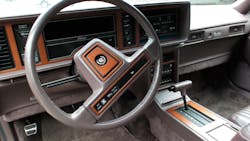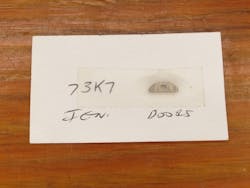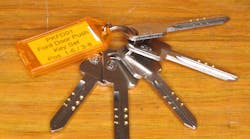Have you ever said, “You dummy!” when you were the only one around? I have, on many occasions, and it typically was after I had done something that I wouldn’t have done if I only had taken a few moments to think before I started.
After almost 50 years of being an automotive locksmith, I still find myself doing stuff that I should have known better than to do. Part of that stems from the fact that I, like all of us, make mistakes. But the part that really gets under my skin is when I waste a lot of time or money by doing something that a moment of thought could have led me to avoid.
Just the other day, I was making keys for a Chevrolet Trax in the rain. After removing the door lock to decode it, I closed the door to keep the rain out of the car while I decoded the lock in my truck. After I had my test key made, I returned to the vehicle to make sure that it worked in the ignition only to find that the outside door handle was locked in place by the same mechanism that held the door lock in place!
Because I hadn’t taken a moment to unlock the other doors, I had to break out the trusty Jiffy-Jak and use it to pull the inside handle to open the door – in the rain! Stuff like that can really mess up your day.
So, the point I’m trying to make here is that taking a few moments when you arrive on the job to consider your course of action before you start can save you hours of work in the long run. When I worked for the U.S. Navy, motivational posters were everywhere. One of my favorites simply said: “If you don’t have time to do the job right the first time, how will you ever find the time to do it over?”
In our line of work as automotive locksmiths, time literally is money, so it’s natural when you hit a job that you have done hundreds of times before to jump right in without a moment of thought. And then you learn that Murphy’s Law isn’t a joke; it’s a simple statement of fact.
Here are a few examples of situations that I’ve been involved in where a little thinking could have saved a LOT of work. My hope is that you’ll learn from some of these examples or at least get a smile from my misfortunes.
Check the Glove Box
I should explain two things. In the years just before airbags, General Motors used a Canadian-made tilt-telescoping steering column on some Buick and Cadillac vehicles that required a special tool or specialized knowledge to be disassembled properly. It was similar to other tilt-telescoping columns, but if you didn’t know the “trick” or have the special tool, you could be in trouble quickly. The Canadian column was easy to identify, because the cruise control buttons were mounted on the horn pad. (Image 2)
Bill got a job to make keys to an almost new Cadillac Seville that had the Canadian steering column and the Vehicle Anti-Theft System (VATS). The employees of a local garage and car wash had dropped the keys down a drain.
About three hours after Bill arrived on the job, I got a call to go and bail him out. When I arrived, I discovered that Bill had no idea why this steering column was different from the others that he had done but plunged in anyway. He managed to get it mostly apart but broke one electrical switch, and most of the components of the steering column had vise-grip scars.
I eventually repaired the switch and got the column the rest of the way apart to get the code number off the side of the lock. I made a mechanical key, reassembled the column and set Bill to work doing the interrogation of the VATS. (I figured that even he couldn’t mess that up!) Then, I went to work making the door key.
When I opened the glove box that had the sliding six-cut sidebar lock (Image 3), I heaved a huge sigh of relief that it was unlocked and that Bill hadn’t tried to take that lock apart. But when I looked into the glove box, the first thing I saw was a small manilla envelope with the words “Key Codes” written on it. I looked inside and shook out the knockouts that had the key codes from the original keys.
It would be an understatement to say I was mad at Bill, but I resisted the urge to use the pistol that also was in the glove box. I just made the door key from the code on the knockout and sent Bill on his merry way so I could complete the interrogation in peace.
- Recently, I had to make keys for an old Buick that was equipped with VATS. The first thing I did was check the glove box. (Image 4) Needless to say, I saved a lot of time on that job. Basically, all I had to do was cut two keys from code and then interrogate the VATS. Murphy’s law wasn’t working that day, because I hit the correct value for the VATS on the second try.
- A few years ago, I had to make keys for a 1993 Chevrolet pickup at an auction. The plastic housing of the door handle assembly was broken so it was hanging out of the door. I didn’t want to touch it, because it would break, and I didn’t want to get stuck fixing it for free. When I looked in the glove box, a key tag was attached to a giveaway keyring that had the two knockouts from the original keys!
- Shortly after Fiat took over Chrysler and we suddenly no longer could get the Immobilizer (PIN) codes from the dealer, I had to make keys for a Dodge Neon at an auction. But when I opened the glove box, I found the key code and the PIN written in the back of the owner’s manual. (Image 5)
Don’t Assume Anything
We all have heard something to the effect of “To assume makes an ass out of you and me.” That’s one of the great truths of life as far as I’m concerned, but I still find myself doing it. If you’re working on a car at an auction, impound or somewhere else where the history on the car is unknown, don’t assume a key isn’t in the vehicle.
One day I had to make keys for a Ford pickup for a regular customer. He asked me to put the key in the ashtray when I was done. After making the key, I opened the ashtray and inside was the original key for the truck. I tried it, and it still worked, because I used the “add a key” procedure. At that point, the simplest thing to do was to make the key that I found disappear. But from that day forward, I always check the ashtray before starting a job like that, and, so far, I’ve found three more keys in ashtrays. I also have found keys under the seat, inside the gas filler flap and in the glove box.
I once had a job to make keys for a new rental car on the beach. The guy who called me didn’t speak English well, but he did know a lot of English profanity. I got to the car before he did and tried the door to see whether it was unlocked. It was, and the car was packed with luggage and beach paraphernalia.
Just for the heck of it, I got in and pressed the brake and the start button to see whether the fob might be in the car. The engine fired right up, and I resigned myself to just charging him for a service call.
But when I called the customer, before I could tell him that the fob was in the car, he immediately started to raise Hell with me for being there in the first place, because he had texted me to cancel the call. Apparently, he decided to have the vehicle towed to the dealer.
I tried to explain that my published phone number was a landline and couldn’t receive texts but got nowhere. He said he was calling the police and hung up. I got out of my truck, locked the car and settled in to wait for the police.
The customer showed up by cab a few minutes later along with his wife and went ballistic that I was still there and that the police weren’t. I told him that he owed me for a service call, and as soon as that was paid, I would be on my way. He yelled at me while shaking his fists, so I got back in my truck to wait for the police. I had to wait a while, because the guy had given them the wrong information, and they were at the wrong end of the beach. Before they arrived, the guy and his wife started to walk back to their hotel, about 4 or 5 miles away.
About a half-mile away, I saw the two tourists trudging through the pouring rain and decided to be a nice guy and offer them a ride back to their hotel. It was at this point that I learned that the guy’s wife knew more profanity than her husband. I apologized for disturbing them and went on about my business watching them recede into the rain in my rearview mirror. My appreciation for Karma went up a notch or two that day.
The point of all of this is that if you don’t know for sure what happened to a prox fob, always try to start the car before you do anything else. I did this once on a Lexus at an auction, and the car started right up. A mechanic and I searched for more than a half-hour but couldn’t find the fob. We concluded that it must have gone down a defroster duct and went ahead and programmed a new prox, which would delete the old one.
But on several other occasions, I was able to locate the fob. I once did a Mazda RX8 that way and eventually found the credit-card shape fob (Image 6) stuck to the foam inside the sunglasses holder on the roof.
Ford Door Issues
Earlier, I mentioned my misadventure with a Chevrolet Trax door handle. As a rule, I don’t remove a door lock that I can pick by using a Lishi tool. I only removed that one because it was raining, and I wanted the job done fast.
On Ford/Lincoln HU-101 door locks, I’ve found that I can pick them more easily if I remove the lock and hold or clamp it vertically in a vise. But there’s a real danger in doing that. On Fords, the outside door handle can pull out of the door easily after the lock has been removed. Putting it back in place will test your patience to the extreme. I compare it with building a ship model in a black bottle while wearing mittens.
I recently had this problem on a Ford Fusion at a body shop that I do a lot of work for. While I was working on the lock inside my van, someone had to open the door to the Fusion, and when they did, the handle came off in their hand. I spent the next couple of hours trying to get that handle back in place.
So, now I avoid removing the lock unless I really am having trouble with it. If I remove the lock, I put masking tape over the handle hopefully to prevent anyone from pulling it.
In other words, if you have a job on a Ford or Lincoln, stop and think: Don’t remove the door lock unless you absolutely have to and then take steps to keep anyone from messing with it while you work on the lock. You’ll be glad you did.
Steve Young has been a locksmith since 1973 and has trained and taught locksmiths since 1988. He is a frequent contributor to Locksmith Ledger.









